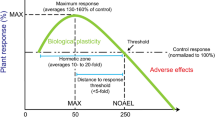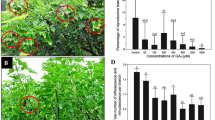Summary
Flower formation in the long-short-day plantBryophyllum daigremontianum induced by the shift from long to short day is fully suppressed by applying the growth retardant CCC [(2-chloroethyl)-trimethylammonium chloride]via the roots during short day treatment at a level of at least 1 g per plant. At the same time CCC applications strongly reduce the internode length, but the rate of leaf formation does not seem to be affected. CCC also causes the production of more anthocyanin in the leaves.
Gibberellin A3 appliedvia the apices and youngest leaves at a dose of 1.5 μg per plant, completely overcomes the inhibition of flower formation caused by CCC. Ten times higher quantities are needed for a complete reversal of the reduction in stem elongation.
The growth retardant CCC seems to keep the level of physiologically active GA below that which is normally required for floral initiation and stem elongation. Thus, the results are in agreement with the hypothesis that a high GA level is necessary for the production of floral stimulus inBryophyllum daigremontianum.
Similar content being viewed by others
Literature
Cathey, H. M., andN. W. Stuart: Comparative plant growth-retarding activity of Amo-1618, Phosfon, and CCC. Bot. Gaz.123, 51–57 (1961).
Lockhart, J. A.: Kinetic studies of certain anti-gibberellins. Plant Physiol.37, 759–764 (1962).
Margara, J.: Étude comparative des effects du bromure d'allyl-trimethylammonium et de l'acide gibbérellique sur le développement d'espèces du genreBeta. Ann. Physiol. vég.3, 93–103 (1961).
Marth, P. C., W. H. Preston jr., andJ. W. Mitchell: Growth-controlling effects of some quarternary ammonium compounds on various species of plants. Bot. Gaz.115, 200–204 (1953).
Penner, J.: Über den Einfluß von Gibberellin auf die photoperiodisch bedingten Blühvorgänge beiBryophyllum. Planta (Berl.)55, 542–572 (1960).
Stuart, N. W.: Initiation of flower buds inRhododendron after application of growth retardants. Science134, 50–52 (1961).
Tolbert, N. E.: (2-chloroethyl)-trimethylammonium chloride and related compounds as plant growth substances. I. Chemical structure and bioassay. J. biol. Chem.235, 475–479 (1960).
Tolbert, N. E.: Structural relationships among chemicals which act like antigibberellins. Advanc. Chem. Ser.28, 145–151 (1961).
Wirwille, J. W., andJ. W. Mitchell: Six new plant-growth-inhibiting compounds. Bot. Gaz.111, 491–494 (1950).
Wittwer, S. H., andN. E. Tolbert: (2-chloroethyl)-trimethylammonium chloride and related compounds as plant growth substances. III. Effect on growth and flowering of the tomato. Amer. J. Bot.47, 560–565 (1960a).
: (2-chloroethyl)-trimethylammonium chloride and related compounds as plant growth substances. V. Growth, flowering, and fruiting responses as related to those induced by auxin and gibberellin. Plant Physiol.35, 871–877 (1960b).
Zeevaart, J. A. D., andA. Lang: The relationship between gibberellin and floral stimulus inBryophyllum daigremontianum. Planta (Berl.)58, 531–542 (1962).
Author information
Authors and Affiliations
Additional information
With 2 Figures in the Text
This work was supported by the National Science Foundation, grants G-16408 and G-17483.
Rights and permissions
About this article
Cite this article
Zeevaart, J.A.D., Lang, A. Suppression of floral induction inBryophyllum daigremontianum by a growth retardant. Planta 59, 509–517 (1963). https://doi.org/10.1007/BF01914994
Received:
Issue Date:
DOI: https://doi.org/10.1007/BF01914994




